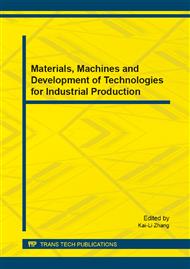[1]
Lau, W. -J. and A.F. Ismail, Polymeric nanofiltration membranes for textile dye wastewater treatment: Preparation, performance evaluation, transport modelling, and fouling control - a review. Desalination, 2009. 245(1-3): pp.321-348.
DOI: 10.1016/j.desal.2007.12.058
Google Scholar
[2]
Capar, G., U. Yetis, and L. Yilmaz, The most effective pre-treatment to nanofiltration for the recovery of print dyeing wastewaters. Desalination, 2007. 212(1-3): pp.103-113.
DOI: 10.1016/j.desal.2006.09.020
Google Scholar
[3]
Ahmad, A.L., S. Ismail, and S. Bhatia, Membrane treatment for palm oil mill effluent: Effect of transmembrane pressure and crossflow velocity. Desalination, 2005. 179(1-3): pp.245-255.
DOI: 10.1016/j.desal.2004.11.071
Google Scholar
[4]
Ahmad, A.L. and B.S. Ooi, A study on acid reclamation and copper recovery using low pressure nanofiltration membrane. Chemical Engineering Journal. In Press, Corrected Proof.
DOI: 10.1016/j.cej.2009.10.014
Google Scholar
[5]
Aouni, A., et al., Treatment of textile wastewater by a hybrid electrocoagulation/nanofiltration process. Journal of Hazardous Materials, 2009. 168(2-3): pp.868-874.
DOI: 10.1016/j.jhazmat.2009.02.112
Google Scholar
[6]
Amar, N.B., et al., Comparison of tertiary treatment by nanofiltration and reverse osmosis for water reuse in denim textile industry. Journal of Hazardous Materials, 2009. 170(1): pp.111-117.
DOI: 10.1016/j.jhazmat.2009.04.130
Google Scholar
[7]
Alcaina-Miranda, M.I., et al., Nanofiltration as a final step towards textile wastewater reclamation. Desalination, 2009. 240(1-3): pp.290-297.
DOI: 10.1016/j.desal.2008.02.028
Google Scholar
[8]
Amy, G., Fundamental understanding of organic matter fouling of membranes. Desalination, 2008. 231(1-3): pp.44-51.
DOI: 10.1016/j.desal.2007.11.037
Google Scholar
[9]
Benítez, F.J., et al., The use of ultrafiltration and nanofiltration membranes for the purification of cork processing wastewater. Journal of Hazardous Materials, 2009. 162(2-3): pp.1438-1445.
DOI: 10.1016/j.jhazmat.2008.06.036
Google Scholar
[10]
Darwish, N.A., et al., Neural Networks Simulation of the Filtration of Sodium Chloride and Magnesium Chloride Solutions Using Nanofiltration Membranes. Chemical Engineering Research and Design, 2007. 85(4): pp.417-430.
DOI: 10.1205/cherd06037
Google Scholar
[11]
Hong, S. and M. Elimelech, Chemical and physical aspects of natural organic matter (NOM) fouling of nanofiltration membranes. Journal of Membrane Science, 1997. 132(2): pp.159-181.
DOI: 10.1016/s0376-7388(97)00060-4
Google Scholar
[12]
Comerton, A.M., R.C. Andrews, and D.M. Bagley, The influence of natural organic matter and cations on fouled nanofiltration membrane effective molecular weight cut-off. Journal of Membrane Science, 2009. 327(1-2): pp.155-163.
DOI: 10.1016/j.memsci.2008.11.013
Google Scholar
[13]
Patterson, D.A., et al., Membrane characterisation by SEM, TEM and ESEM: The implications of dry and wetted microstructure on mass transfer through integrally skinned polyimide nanofiltration membranes. Separation and Purification Technology, 2009. 66(1): pp.90-97.
DOI: 10.1016/j.seppur.2008.11.022
Google Scholar
[14]
Wang, K.Y. and T. -S. Chung, Fabrication of polybenzimidazole (PBI) nanofiltration hollow fiber membranes for removal of chromate. Journal of Membrane Science, 2006. 281(1-2): pp.307-315.
DOI: 10.1016/j.memsci.2006.03.045
Google Scholar
[15]
Comerton, A.M., R.C. Andrews, and D.M. Bagley, The influence of natural organic matter and cations on the rejection of endocrine disrupting and pharmaceutically active compounds by nanofiltration. Water Research, 2009. 43(3): pp.613-622.
DOI: 10.1016/j.watres.2008.11.003
Google Scholar
[16]
Anim-Mensah, A.R., W.B. Krantz, and R. Govind, Studies on polymeric nanofiltration-based water softening and the effect of anion properties on the softening process. European Polymer Journal, 2008. 44(7): pp.2244-2252.
DOI: 10.1016/j.eurpolymj.2008.04.036
Google Scholar
[17]
Bowen, W.R., et al., Modelling the performance of membrane nanofiltration-application to an industrially relevant separation. Journal of Membrane Science, 2004. 242(1-2): pp.211-220.
DOI: 10.1016/j.memsci.2004.04.028
Google Scholar



